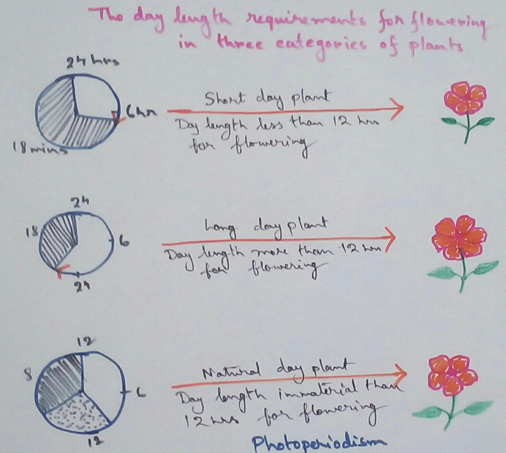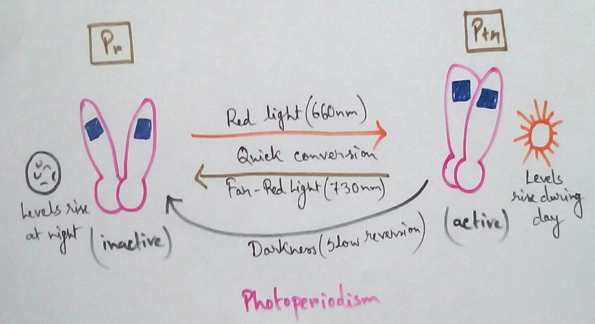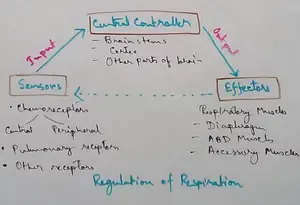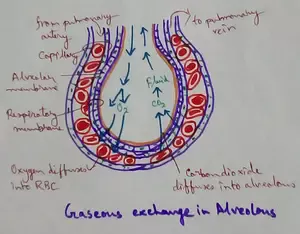Photoperiodism - Long Day and Short Day Plant
Definition of Photoperiodism - Photoperiodism is a process where the response of a particular flowering plant to the effective day length with respect to flowering occurs.
In 1920 and in 1922 Garner and Allard in a variety of soybean made some experiments for understanding this photoperiodism.
This process occurs due to the effect of duration of light and darkness,on the growth development and behavior of organisms. This is specially connected with flowering of plants, formation of underground storage organs, leaf fall etc. The effect of photoperiodism on flowering was first discovered by Garner and Allard in 1920 in case of Maryland Mammoth, variety of tobacco. On the basis of photoperiods plants are of different types.
Types of plants according to the photoperiodism - It can be divided into 5 types due to the duration of the receiving light and they are following.
Long day plants - plants belong to this category receive light above a critical length. Examples are wheat, oat, sugar beet, spinach, radish, lettuce.
Short Day Plants - plants belong to this category have flower which only when they receive light below are critical length are able to bloom.
Examples are - Potato, tobacco, xanthium, Dahlia, rice, Chrysanthemum, glycine Max etc.
Day Neutral Plants - Photo periods do not have any impact on this type of plants which come to flower and after completing their vegetative growth. Examples of this type of plants at Tomato, maize, cotton, sunflower, cucumber.
Short long day plants - Short photo periods are characteristics for this type of plants for initiation of flowering and long photo periods for blossoming. Examples of Trifolium repens, Campanula medium.
Long short day plants - In case of this type of plants long photo periods are observed for initiation of flowering and short photo periods for blossoming. Examples of bryophyllum, Cestrum.
Day neutral plants are maximum found in tropical areas as they can be make to flower throughout the year. In the subtropical and temperate areas short day plants flower during the autumn season and spring season where is long day plants flower during summer. Plants that have sensitivity for critical day length is that continuous duration of flight which must always be exceeded in long day plants and must not be exceeded in short day plants. Critical dark period is the continuous duration of darkness which must be exceeded in short day plants and must not be exceeded in long day plants. Long day plants do not require continuous dark period and are therefore called short night plans on the other hand short day plants are known as long night plans because any interruption of critical period given by a flash of light prevents flowering. This latter type of plant is called light break reaction.
Photoperiodic induction - Photoperiodic induction as we all know that normally a plant requires one or more inductive cycles for flowering. The appropriate photo period in a 24 hours cycle normally is made up an inductive cycle. If the plant receives the sufficient number of inductive cycles and then it continuously placed under unfavourable photoperiods then it will still have flowers. This type of induction of flowering of a plant is controlled by the effect of photo inductive cycle called photoperiodic induction. This can be explain with example where plants like soyabean required only to inductive cycles while salvia requires 17 inductive cycles and plantago requires 25 inductive cycles. Here swelling is a short day plants salvia is short day plants and plantago is long day plants. In some cases the increase in number of inductive cycle may bring about early flowering in some plants. Like xanthium flowers after 64 days on receiving one inductive cycle but the flowering is brought forward to 13 days on receive of 4 - 8 inductive cycles.In 1936 Chailakhyan proposed that photoperiodic induction produces a chemical Complex florigen for flowering and was confirmed by flowering of non induced plants brought in organic contact with induced plants through grafting. The floor design has not yet been extracted not identified till now.
Presence of phytochrome -
Definition of Phytochrome - It is a proteinaceous pigment present in plants which stimulates flowering in long day plants while it anyway it’s flowering in short day plants.
Form of existence - It can exist into interconvertible forms. These are-
Red light with wavelength of 660 milli micron to 665 Milli Micron that absorb form which is known as PR and it converted into PFR while absorbing red light.
Far Red Light having wavelength of 730 milli micron to 735 Milli Micron while absorbing form is pfr and it converted to PR while absorbing far red light.
In the short day plants during the critical dark phase the PFR are gradually converted to PR resulting in flowering on the other hand a brief exposure to far red light again transfer it back to PFR and thus it inhibits flowering. Thus anybody effect of red light can be reversed by the subsequent exposure of far Red Light.
In case of long day plants the interruption of dark period by red light can result in further accumulation of paper and thereby is stimulated.
Importance of photoperiodism - Photoperiodism is very important for plant life-
* Photoperiodism helps in hybridization of experiment.
* Mechanism of flowering in plants can be clearly understood by this activity.
* Physiological preconditioning of the plant can be achieved which induces flowering in plants.
* On the basis of photoperiodism plants can be classified into different categories like long day plants and short day plants.
Characteristics of short day plants -
* In short day plants that period is critical if it is interrupted with the brief exposure of red light of wavelength 660 to 665 millimicron they do not bloom.
* The introduction of lightning created by red light may not in a week flowering in them but if the dark period is prolonged and flowering can be induced early.
Characteristics of long day plants-
* The lighting period is critical for long day plants and prolongation of the light period in this plan stimulates early flowering.
* Brief exposure to light during the dark period may also stimulates flowering in this type of plants.
From Photoperiodism Long Day and Short Day Plant to HOME PAGE
Recent Articles
-
Disorders of Respiratory System | Tuberculosis | Pleurisy | Emphysema
Oct 28, 25 11:39 PM
Tuberculosis is very common disease and is caused by a type of bacteria called Mycobacterium tuberculosis. This disease causes different trouble in the respiration and infection of several parts of th… -
Regulation of Respiration | Respiratory Centres | Inspiratory Area |
Oct 14, 25 12:13 AM
Respiratory Centre is the area that controls the rate of respiration and it is observed to be located in medulla oblongata and pons. Respiratory Centre has the following will dispersed components like… -
Explain Transport of Gases | External Respiration | Tissue Respiration
Oct 09, 25 11:35 PM
In humans gaseous exchange is completed in the following ways the steps are - External Respiration or Breathing - Breathing in false taking in of Oxygen and giving out of carbon dioxide in the body. M… -
Kind and Number of Teeth | Location of Teeth in Mouth | Care of Teeth
Sep 11, 25 12:52 AM
Kind and Number of Teeth -
The Gaseous Exchange | Transport of Oxygen | Haldane Effect |
Sep 10, 25 02:44 PM
Oxygen carrying capacity of blood is 20 ml for 100m but 3% of dissolved in plasma and 97% of the oxygen combines with haemoglobin to form a loose reversible Complex called oxyhaemoglobin and is transp…







New! Comments
Have your say about what you just read! Leave me a comment in the box below.